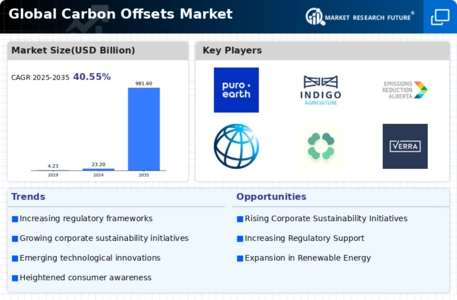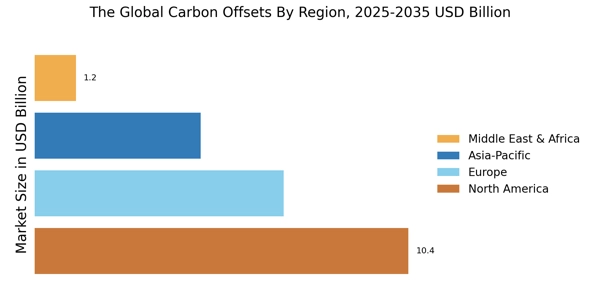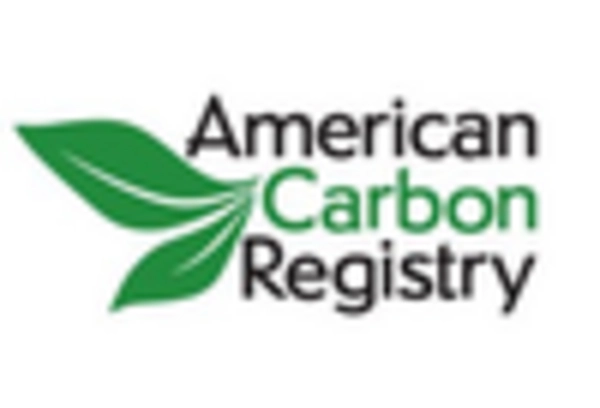Rising Environmental Awareness
The increasing awareness of climate change and its impacts is driving the demand for carbon offsets. Consumers and businesses alike are becoming more conscious of their carbon footprints, leading to a surge in interest in sustainable practices. This heightened awareness is reflected in The Global Carbon Offsets Industry, where the demand for carbon credits is expected to rise significantly. According to recent estimates, the market could reach a valuation of several billion dollars by 2025, as more entities seek to mitigate their environmental impact. This trend is further supported by educational campaigns and advocacy from environmental organizations, which emphasize the importance of reducing greenhouse gas emissions. As a result, The Global Carbon Offsets Industry is likely to experience robust growth, fueled by a collective push towards sustainability.
Government Regulations and Policies
Government regulations and policies aimed at reducing carbon emissions are playing a crucial role in shaping The Global Carbon Offsets Industry. Many countries are implementing stricter emissions targets and carbon pricing mechanisms, which create a demand for carbon offsets as a compliance tool. For instance, cap-and-trade systems and carbon taxes incentivize businesses to invest in carbon credits to meet regulatory requirements. As governments continue to strengthen their climate policies, the market for carbon offsets is expected to expand. Recent data suggests that regions with robust regulatory frameworks are witnessing a surge in carbon credit transactions, indicating a growing reliance on offsets as a means of achieving emissions reductions. This regulatory landscape is likely to drive innovation and investment in The Global Carbon Offsets Industry.
Corporate Sustainability Initiatives
Many corporations are increasingly adopting sustainability initiatives as part of their business strategies. This trend is particularly evident in industries with high carbon emissions, where companies are actively seeking ways to offset their environmental impact. The Global Carbon Offsets Industry is benefiting from this shift, as businesses invest in carbon credits to meet their sustainability goals. Reports indicate that a significant percentage of Fortune 500 companies have committed to achieving net-zero emissions by 2050, which necessitates the purchase of carbon offsets. This corporate commitment not only enhances brand reputation but also aligns with consumer expectations for environmentally responsible practices. Consequently, The Global Carbon Offsets Industry is poised for growth as more companies recognize the value of integrating carbon offsets into their operational frameworks.
Technological Advancements in Carbon Accounting
Technological advancements in carbon accounting and tracking are enhancing the efficiency and transparency of The Global Carbon Offsets Industry. Innovations such as blockchain technology and artificial intelligence are being utilized to improve the accuracy of carbon credit verification and monitoring processes. These technologies enable more reliable tracking of emissions reductions, which is essential for building trust in carbon offset projects. As a result, stakeholders are more likely to engage in the market, knowing that their investments are backed by credible data. Furthermore, the integration of technology in carbon offset transactions is streamlining processes, making it easier for businesses and individuals to purchase and trade carbon credits. This technological evolution is expected to contribute to the growth of The Global Carbon Offsets Industry, as it fosters greater participation and investment.
Increased Investment in Renewable Energy Projects
The growing investment in renewable energy projects is significantly influencing The Global Carbon Offsets Industry. As countries and companies strive to transition to cleaner energy sources, the demand for carbon offsets generated from renewable energy initiatives is on the rise. Projects such as wind, solar, and hydroelectric power not only contribute to emissions reductions but also generate carbon credits that can be sold in the market. Recent trends indicate that investments in renewable energy are expected to reach trillions of dollars over the next decade, further bolstering the carbon offset market. This influx of capital into sustainable energy projects is likely to create a robust supply of carbon credits, thereby enhancing the overall dynamics of The Global Carbon Offsets Industry. The synergy between renewable energy investment and carbon offsets presents a promising avenue for achieving climate goals.


















Leave a Comment